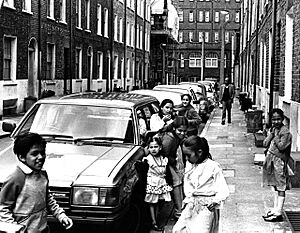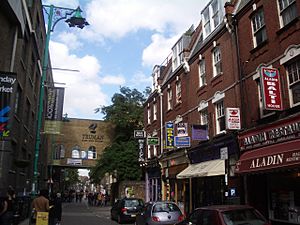History of Bangladeshis in the United Kingdom facts for kids
Bangladeshis are one of the largest immigrant groups in the United Kingdom. Many Bengalis, especially from the Sylhet Division in Bangladesh, came to Britain as early as the 1600s. Most of these early arrivals were lascar seamen who worked on ships.
After Bangladesh became an independent country in 1971, many more people moved to Britain during the 1970s. This led to the creation of the British Bangladeshi community we know today. People were encouraged to move to Britain because of new immigration laws, natural disasters like the 1970 Bhola cyclone, the Bangladesh Liberation War against Pakistan, and the hope of escaping poverty. Many Sylheti men brought their families to Britain, hoping for a better life. However, during the 1970s and 1980s, Bangladeshis faced racism and attacks from groups like the National Front and the British National Party.
Contents
Early Bengali Settlers in Britain
From the 1600s to the early 1900s, the British East India Company hired thousands of lascars and workers from South Asia. Many of these were Muslim people from Sylhet and Sikh people from Punjab. They worked on British ships. Because most early Sylheti settlers were seamen, the first Muslim communities in Britain were found in port towns. Naval cooks and waiters also came.
One famous early Bengali Muslim immigrant was Sake Dean Mahomet. He was a captain in the British East India Company. In 1810, he opened London's first Indian restaurant, called the Hindoostane Coffee House. He is also known for bringing shampoo and special massages to the UK. Records show that other Sylhetis worked in London restaurants from at least 1873. By the start of World War I, over 51,000 South Asian lascars worked on British ships, and most of them were Bengali.
At that time, there were not many Sylheti women in Britain. So, some early Bengali sailors married local white British women. This happened partly because of poor treatment and rules that limited South Asian sailors on British ships. Because of this, most early British-born Bengalis were of 'mixed-race' background, sometimes called 'Anglo-Indian' or 'Eurasian'. Famous examples include Albert Mahomet and Frederick Akbar Mahomed. Most of these mixed-race children also became part of British society by marrying local white people. So, a lasting British Bengali community did not form until Bangladeshi women started arriving in large numbers from the 1970s. After that, most Bangladeshis chose to marry each other, which helped create a permanent British Bangladeshi community.
Why Bangladeshis Moved to the UK
People from Bangladesh moved to the United Kingdom mainly to find work and earn a better living. Many Bangladeshi men came to the UK for jobs in the 1950s and 1960s. These men are known as the first generation of Bangladeshi settlers. When they arrived, they settled in industrial cities and towns. These included Birmingham, Luton, Bedford, Oldham, Manchester, Leeds, Bradford, Liverpool, and parts of London like Camden, Westminster, Hackney, Newham, Redbridge, and Tower Hamlets. They especially settled around Spitalfields and Brick Lane to find steady jobs and better pay. Most Bangladeshi people in the UK come from the Sylhet region in the north-east of Bangladesh.
The Immigration Act of 1971 came into effect in 1972. This law placed many limits on how many people could move from Bangladesh to the UK. It only allowed family members, like wives and children under 16, to join their husbands and fathers who were already living in the UK. So, after this law, mostly family members immigrated. From the mid-1970s, the UK's economy became weaker, which made it harder for men to bring their families over.
In the late 1970s, many Sylheti people lost their jobs. This was because they worked in heavy industries that were either taken over by private companies or closed down. Because of this, many Sylheti people started their own restaurants and takeaway businesses across the country. This trend was also followed by Pakistani and Indian communities in the UK. From this point on, 'curry houses', also known as Indian restaurants, became very popular everywhere. Some Sylheti people became famous chefs and wealthy business owners, starting from humble beginnings. Brick Lane and the areas around it in Tower Hamlets became especially famous for their curry houses.
Bangladesh's Fight for Freedom
In 1971, Bangladesh (then called East Pakistan) went to war against West Pakistan (Pakistan) to gain its independence. This war was known as the Bangladesh Liberation War. The Pakistani army began to take over the Sylhet region, where many Bangladeshis come from. This led some people to join the Mukti Bahini, a freedom fighting group, to defend their land against the Pakistanis.
For example, Muhammad Ataul Gani Osmani was from Sylhet. He commanded the Teliapara Tea Estate in Sylhet and later became the commander-in-chief of the Bangladesh Armed Forces in April 1971. He was one of many who helped Bangladesh win the war. He passed away in 1984 in London, where he was living with his family while battling cancer. Even with these heroic efforts, the war caused many Sylhetis to flee their homes and arrive in the UK during the 1970s.
Bengalis living in Britain also played a part in the War of Independence. In August 1969, Bangladeshi settlers in Birmingham formed the East Pakistan Liberation Front. Its president was Abdus Sabur Choudhury, and Azizul Hoque Bhuia was the secretary. A newspaper called Bidrohi Bangla was published every two weeks by Mr. Mustafizur Rahman. When news of the Pakistani military action on March 25, 1971, reached Britain, a large gathering took place in Birmingham's Smallheath Park. Over 10,000 Bengalis were there. At this gathering, the East Pakistan Liberation Front was ended, and the Bangladesh Action Committee was formed. Justice Abu Saeed Chowdhury became its president, and Azizul Hoque Bhuia was the secretary.
Here are some of the actions and movements they organized:
- March 5, 1971: A protest in front of the Pakistan High Commission in London. They burned flags and gave a letter to the high commissioner, asking for liberation.
- March 7, 1971: An all-party gathering in Smallheath Park, Birmingham, where they declared independence.
- March 28: The Bangladesh Flag was raised in Smallheath Park, Birmingham.
- May 3, 1971: 300 Members of the British Parliament agreed to support the Bangladesh movement.
- June 21, 1971: 120 Bengalis traveled to Paris to protest against a meeting of 12 developed countries that were considering giving aid to Pakistan. Pakistan did not receive any aid.
- June 30, 1971: A Pakistani ship called Padma, full of weapons, was at the port in Montreal, Canada. The Bangladesh Action Committee protested in front of the Canadian High Commission, and the Canadian government eventually stopped the ship.
Thanks to these movements and protests, Western media, activists, and governments turned against Pakistan and helped Bangladesh gain its freedom. Bengalis in Britain played a very important role in Bangladesh's independence.
First Bangladeshi Communities

Bangladeshis started arriving in the UK in large numbers in the 1970s. Most of them settled in and around the Brick Lane area of East London. However, some Bengalis had been in the country as early as the 1920s, though very few. Author Caroline Adams wrote about an event in 1925. A lost Bengali person looking for other Bengalis in London was told by a policeman, "you better go on until you smell curry." At this time, there were many more Jewish people in London than Bengalis. Some of these early Bengalis were Sylhetis who came to Britain by sea after working as lascars on ships.
One of the earliest Bengali immigrants was Sake Dean Mahomed. He was a captain in the British East India Company. In 1810, he opened London's first Indian restaurant, the Hindoostane Coffee House. He is also known for bringing shampoo and therapeutic massage to Britain.
Bangladeshis who came to the UK hoped to find great opportunities. However, many faced different problems. They lived and worked in small, crowded basements and attics in Tower Hamlets. Centuries before, these same buildings had housed Huguenot immigrants who wove silk and worked long hours in cold, poorly lit workshops. The Bengalis found they could not easily talk to English-speaking people. This meant they could not go to higher education. There was also a decline in businesses across East London, which led to unemployment for Bangladeshi workers. The clothing manufacturing industry was part of this decline.
Instead, Bangladeshis became cooks, waiters, and mechanics. But their progress up the social and economic ladder was slow. The men often could not read or write well, had little education, and spoke little English. This made them easy targets for some dishonest people from their own community. These people took control of their housing in Whitechapel in the 1970s and sold the properties to other Sylhetis, many of whom had no legal right to the buildings.
By 1970, Brick Lane and many nearby streets were mostly Bengali. Jewish bakeries became curry houses, jewelry shops became sari stores, and synagogues became clothing factories. In 1976, the synagogue at the corner of Fournier Street and Brick Lane became the Jamme Masjid (community mosque). This building shows the history of different immigrant communities in this part of London. In 1743, it was built as a French Protestant Church. In 1819, it became a Methodist Chapel. Then, in 1898, Jewish people used it as the Spitalfields Great Synagogue. As more Bengalis moved to the area, the Jewish community moved to other parts of London as they became more integrated with the main British population. They sold the synagogue, which then became the Jamme Masjid, or 'Great London Mosque'. It still serves the Bangladeshi community today. A film released in 2007, named after Brick Lane, is based on a novel by author Monica Ali.
Official Recognition and Community Growth
In April 2001, the London Borough of Tower Hamlets council officially changed the name of the 'Spitalfields' voting area to Spitalfields and Banglatown. Streets nearby were redecorated, with lamp posts painted green and red, which are the colors of the Bangladeshi flag.
In 2004, Channel S was started. This is a free-to-air television channel made for the British Bangladeshi community.
Images for kids



